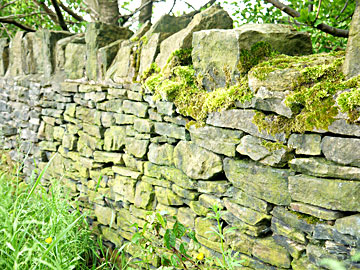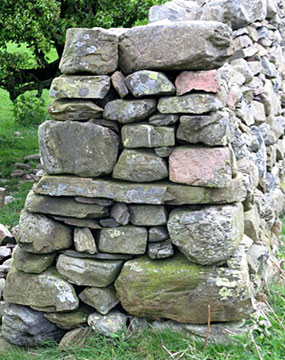Dry Stone Walling
Raw Materials for Dry Stone Walls
If you are fortunate enough to live where there is a plentiful and inexpensive supply of stone, then you will be able to build walls, dividers, retainers, containers and other garden structures using dry stone walling techniques.
Whilst originally intended for building field boundaries from readily available natural materials, without the need for other building supplies such as cement, the same techniques can be used or adapted for structures in your garden.
Almost any kind of stone can be used. Some stone is relatively easy to dress (cut to shape) whilst other kinds of stone are very hard and difficult to cut with only hand tools and therefore the finished wall has a more rough and ready rugged appearance.
Stability of Dry Stone Walls

The general idea is to build walls from randomly sized stones in such a way as to ensure long lasting stability that is able to withstand the most severe weather conditions and most other attacks from animals, for examples. Stones are selected and assembled in such a way that they naturally interlock. The stability and strength of the wall comes about from a combination of interlocking stones and the forces of compression resulting from the weight of the stones.
Because of the random appearance of the stone structure, it has a more natural and traditional appearance that many find more attractive than formal structures built from bricks or blocks.
There are some materials such as slate that lend themselves to quite consistent thicknesses. At the other extreme, walls can be built from rounded boulders and large pebbles which are much more variable in size, shape and weight. Each kind of stone produces its own style and appearance of wall so if stone is plentiful in your locality, it may be preferable to use local stone so that the appearance is consistent with other structures close by.
Dry stone walling is a skilled craft that requires years of instruction and practice to do well. However, with patience and a willingness to work slowly and carefully, an amateur should be able to produce an acceptable wall as long as it is kept simple and straightforward in design. If more sophisticated features are required such as arches, then it is probably better to call in the professionals.

Structure of Dry Stone Walls
The unique form of construction imposes some limitations on dry stone walls, particularly in regard to dimensions. Using traditional techniques, a dry stone wall that is much more than five feet high is likely to be unstable. If additional height is needed, it will be necessary to cement the stones together, which is not strictly dry stone walling though it is usually possible to keep the cement away from the outside faces of the wall and therefore preserve an appearance of the real thing.
At its base, a dry stone wall needs to be at least 18 inches wide and could be up to half the finished height of the wall. It follows that dry stone walling is unlikely to be appropriate where space is at a premium.
To provide the necessary strength and stability, a dry stone wall should also taper in from the base to its top. The precise taper is not critical but it should be at least an inch for every two feet in height. In fact many dry stone walls are twice as wide at the base as they are at the top.
Read more about Dry Stone Walling |
Read about more Gardening Techniques |
